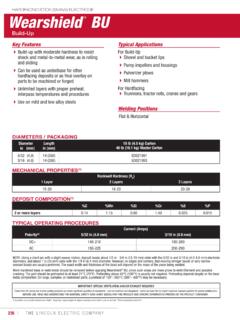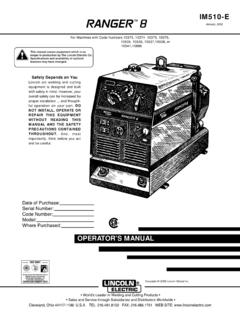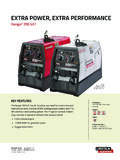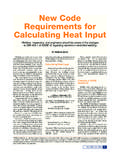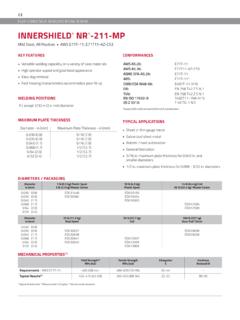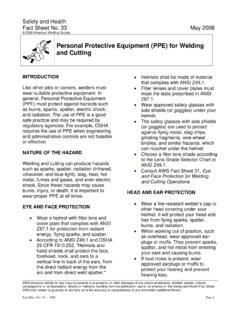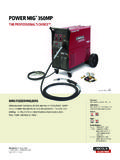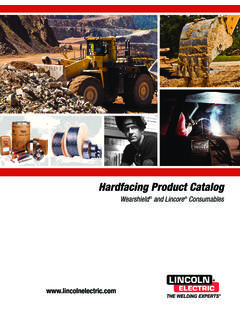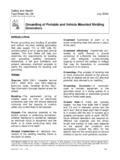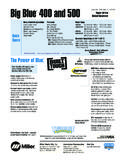Transcription of Weld Cracking - Lincoln Electric
1 weld CrackingAn Excerpt from The Fabricators' and Erectors'Guide to Welded Steel ConstructionThe James F. Lincoln arc welding Foundation1 weld CrackingSeveral types of discontinuities may occur in welds orheat affected zones. Welds may contain porosity, slaginclusions or cracks. Of the three, cracks are by far themost detrimental. Whereas there are acceptable limitsfor slag inclusions and porosity in welds, cracks arenever acceptable. Cracks in a weld , or in the vicinity ofa weld , indicate that one or more problems exist thatmust be addressed. A careful analysis of crack charac-teristics will make it possible to determine the cause andtake appropriate corrective the purposes of this section, Cracking will be dis-tinguished from weld failure.
2 Welds may fail due toover-load, underdesign, or fatigue. The Cracking dis-cussed here is the result of solidification, cooling, and thestresses that develop due to weld shrinkage. weld crack-ing occurs close to the time of fabrication. Hot cracksare those that occur at elevated temperatures and are usu-ally solidification related. Cold cracks are those thatoccur after the weld metal has cooled to room tempera-ture and may be hydrogen related. Neither is the resultof service forms of Cracking result from the shrinkage strainsthat occur as the weld metal cools. If the contraction isrestricted, the strains will induce residual stresses thatcause Cracking .
3 There are two opposing forces: thestresses induced by the shrinkage of the metal, and thesurrounding rigidity of the base material. The shrinkagestresses increase as the volume of shrinking metalincreases. Large weld sizes and deep penetrating weld -ing procedures increase the shrinkage strains. The stress-es induced by these strains will increase when higherstrength filler metals and base materials are a higher yield strength, higher residual stresses willbe conditions of high restraint, extra precautionsmust be utilized to overcome the Cracking tendencieswhich are described in the following sections.
4 It isessential to pay careful attention to welding sequence,preheat and interpass temperature, postweld heat treat-ment, joint design, welding procedures, and filler mater-ial. The judicious use of peening as an in-process stressrelief treatment may be necessary when fabricating high-ly restrained CrackingCenterline Cracking is characterized as a separation in thecenter of a given weld bead. If the weld bead happens tobe in the center of the joint, as is always the case on a sin-gle pass weld , centerline cracks will be in the center ofthe joint. In the case of multiple pass welds, where sev-eral beads per layer may be applied, a centerline crackmay not be in the geometric center of the joint, althoughit will always be in the center of the bead (Figure 1).
5 Centerline Cracking is the result of one of the followingphenomena:segregation induced Cracking , bead shapeinduced Cracking , or surface profile induced , all three phenomena reveal themselves inthe same type of crack, and it is often difficult to identi-fy the cause. Moreover, experience has shown that oftentwo or even all three of the phenomena will interact andcontribute to the Cracking problem. Understanding thefundamental mechanism of each of these types of center-line cracks will help in determining the corrective induced crackingoccurs when low meltingpoint constituents such as phosphorous, zinc, copper andsulfur compounds in the admixture separate during theweld solidification process.
6 Low melting point compo-nents in the molten metal will be forced to the center ofthe joint during solidification, since they are the last tosolidify and the weld tends to separate as the solidifiedmetal contracts away from the center region containingthe low melting point centerline Cracking induced by segregation isexperienced, several solutions may be the contaminant usually comes from the basematerial, the first consideration is to limit the amount ofcontaminant pick-up from the base material. This maybe done by limiting the penetration of the weldingprocess. In some cases, a joint redesign may be desir-able.
7 The extra penetration afforded by some of theprocesses is not necessary and can be reduced. This canbe accomplished by using lower welding 1 Centerline cracking2A buttering layer of weld material (Figure 2), depositedby a low energy process such as shielded metal arc weld -ing, may effectively reduce the amount of pick-up ofcontaminant into the weld the case of sulfur, it is possible to overcome the harm-ful effects of iron sulfides by preferentially forming man-ganese sulfide. Manganese sulfide (MnS) is createdwhen manganese is present in sufficient quantities tocounteract the sulfur. Manganese sulfide has a meltingpoint of 2,900 F.
8 In this situation, before the weld metalbegins to solidify, manganese sulfides are formed whichdo not segregate. Steel producers utilize this conceptwhen higher levels of sulfur are encountered in the ironore. In welding , it is possible to use filler materials withhigher levels of manganese to overcome the formation oflow melting point iron sulfide. Unfortunately, this con-cept cannot be applied to contaminants other than second type of centerline Cracking is known asbead shape induced Cracking . This is illustrated inFigure 3 and is associated with deep penetratingprocesses such as SAW and CO2shielded a weld bead is of a shape where there is moredepth than width to the weld cross section, the solidify-ing grains growing perpendicular to the steel surfaceintersect in the middle, but do not gain fusion across thejoint.
9 To correct for this condition, the individual weldbeads must have at least as much width as vary from a 1:1 to a :1 width-to-depth ratio to remedy this condition. The total weldconfiguration, which may have many individual weldbeads, can have an overall profile that constitutes moredepth than width. If multiple passes are used in this sit-uation, and each bead is wider than it is deep, a crack-free weld can be centerline Cracking due to bead shape is experi-enced, the obvious solution is to change the width-to-depth relationship. This may involve a change in jointdesign. Since the depth is a function of penetration, it isadvisable to reduce the amount of penetration.
10 This canbe accomplished by utilizing lower welding amperagesand larger diameter electrodes. All of these approacheswill reduce the current density and limit the amount final mechanism that generates centerline cracks issurface profile conditions. When concave weld sur-faces are created, internal shrinkage stresses will placethe weld metal on the surface into tension. Conversely,when convex weld surfaces are created, the internalshrinkage forces will pull the surface into situations are illustrated in Figure 4. Concaveweld surfaces frequently are the result of high arc volt-ages.
